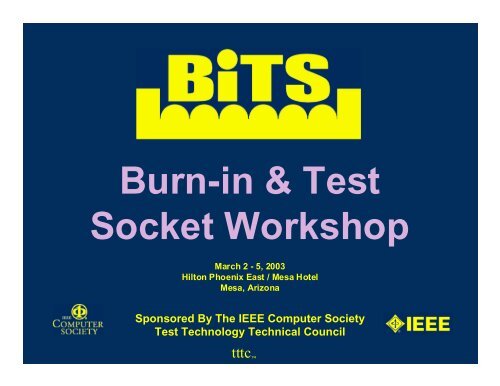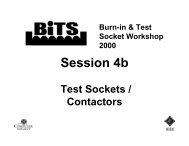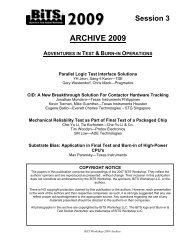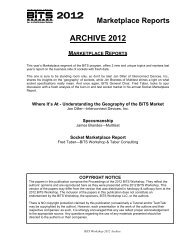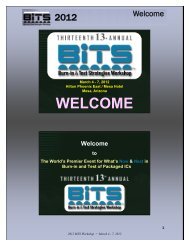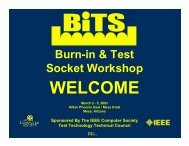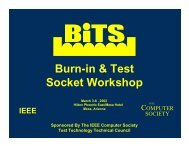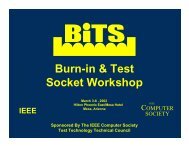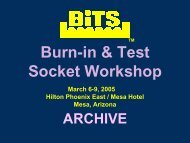Burn-in & Test Socket Workshop - BiTS Workshop
Burn-in & Test Socket Workshop - BiTS Workshop
Burn-in & Test Socket Workshop - BiTS Workshop
- No tags were found...
Create successful ePaper yourself
Turn your PDF publications into a flip-book with our unique Google optimized e-Paper software.
<strong>Burn</strong>-<strong>in</strong> & <strong>Test</strong><strong>Socket</strong> <strong>Workshop</strong>March 2 - 5, 2003Hilton Phoenix East / Mesa HotelMesa, ArizonaSponsored By The IEEE Computer Society<strong>Test</strong> Technology Technical Counciltttc
COPYRIGHT NOTICE• The papers <strong>in</strong> this publication comprise the proceed<strong>in</strong>gs of the 2003<strong>BiTS</strong> <strong>Workshop</strong>. They reflect the authors’ op<strong>in</strong>ions and are reproduced aspresented , without change. Their <strong>in</strong>clusion <strong>in</strong> this publication does notconstitute an endorsement by the <strong>BiTS</strong> <strong>Workshop</strong>, the sponsors, or theInstitute of Electrical and Electronic Eng<strong>in</strong>eers, Inc.· There is NO copyright protection claimed by this publication. However,each presentation is the work of the authors and their respectivecompanies: as such, proper acknowledgement should be made to theappropriate source. Any questions regard<strong>in</strong>g the use of any materialspresented should be directed to the author/s or their companies.
<strong>Burn</strong>-<strong>in</strong> & <strong>Test</strong> <strong>Socket</strong><strong>Workshop</strong>Technical ProgramSession 3Tuesday 3/04/03 8:00AM<strong>Socket</strong> And Board Development“CAF Effect: Challenges For F<strong>in</strong>e Pitch <strong>Burn</strong>-<strong>in</strong> Board Design”K. W. Low - Intel CorporationAnthony Yeh Chi<strong>in</strong>g Wong - Intel CorporationHon Lee Kon - Intel Corporation“Automated <strong>Burn</strong>-<strong>in</strong> <strong>Socket</strong> <strong>Test</strong><strong>in</strong>g And Evaluation”Holger Hoppe - Inf<strong>in</strong>eon Technologies AG“Thermal <strong>Test</strong><strong>in</strong>g Of <strong>Burn</strong>-In <strong>Socket</strong>s”James Forster - Texas InstrumentsSavithri Subramanyam - Texas Instruments
CAF Effect:Challenges for F<strong>in</strong>e Pitch BIB DesignAnthony Wong Yeh Chi<strong>in</strong>gKon Hon LeeLow KWIntel Corporation
•OverviewAgenda• Background & Def<strong>in</strong>ition• CAF Formation• Factors Contribut<strong>in</strong>g to CAF• F<strong>in</strong>e Pitch BIB Design Rules• Best Known <strong>Test</strong> Methods & Issues.• F<strong>in</strong>d<strong>in</strong>gs on PCB Materials Investigated• Technical Challenges.Anthony WongHL Kon/Low KW<strong>BiTS</strong> 2003 2
Overview• Most Wireless & Network<strong>in</strong>g products have cont<strong>in</strong>uouslyshrunk <strong>in</strong> size due to consumer need for smaller, lighter,powerful, and portable devices.• Over the years, technology companies have migrated theproduct p<strong>in</strong> pitch from 1.27mm to 0.5mm and less.1.27mm pitch0.5mm pitch• Due to the tight pitch, f<strong>in</strong>e pitch PCBs are moresusceptible to CAF failure which will cause the board tofail electrically <strong>in</strong> the field after some time <strong>in</strong> use.Anthony WongHL Kon/Low KW<strong>BiTS</strong> 2003 3
Background & Def<strong>in</strong>ition• CAF is the acronym for Conductive Anodic Filament.• Discovered by Bell Lab <strong>in</strong> 1976.• Further research has been performed by U of Maryland(CALCE), Georgia Institute of Technology & SunMicrosystems.• CAF is the growth of a copperconta<strong>in</strong><strong>in</strong>gfilament subsurfacealong the epoxy-glass <strong>in</strong>terface,from anode to cathode.Anthony WongHL Kon/Low KWSource:School of Materials Science & Eng<strong>in</strong>eer<strong>in</strong>g,GIT, Atlanta, GA<strong>BiTS</strong> 2003 4
CAF Formation• Glass/epoxy bonds degrade – due to mechanical stress,poor quality coupl<strong>in</strong>g agent, etc.• In a humid environment, water absorption occurs and createsan aqueous medium that provides an electrochemicalpathway that facilitates the transport of corrosion products.• Water acts as the electrolyte, copper circuitry as anode &cathode and operat<strong>in</strong>g voltage as driv<strong>in</strong>g potential.• H+ (pH lower) and OH- (pH higher) creates a pH gradient.• Copper is passivated <strong>in</strong> region of pH 7 to 11 but becomescorrosive at pH below 7 and potentials greater than 0.2V.• The anodic copper ions travel along the epoxy/fiber <strong>in</strong>terfaceattracted to the cathode.Anthony WongHL Kon/Low KW<strong>BiTS</strong> 2003 5
Factors Contribut<strong>in</strong>g to CAF(1)• Material:• Several experiments have been done by PCB lam<strong>in</strong>atesuppliers.• Most PCB Materials are only CAF ResistiveAnthony WongHL Kon/Low KW<strong>BiTS</strong> 2003 6
Factors Contribut<strong>in</strong>g to CAF(2)• Conductor Configuration:Most susceptibleSource:School of Materials Science & Eng<strong>in</strong>eer<strong>in</strong>g, GIT, Atlanta, GALeast susceptible• Voltage Gradient Effects: 3-8V/mils• Solder Flux/HASL(Hot Air Solder Level<strong>in</strong>g) FluidComposition:• <strong>Test</strong><strong>in</strong>g shows that polyglycols diffuse <strong>in</strong>to epoxy dur<strong>in</strong>gsolder<strong>in</strong>g and <strong>in</strong>creases moisture absorption by thesubstrate.• Thermal Excursions:• Temperature , amount of polyglycol absorption• Will weaken the bond<strong>in</strong>g between epoxy and glass fibersdue to difference <strong>in</strong> Coefficient of Thermal Expansion.Anthony WongHL Kon/Low KW<strong>BiTS</strong> 2003 7
Factors Contribut<strong>in</strong>g to CAF(3)• Clean<strong>in</strong>g:• Polyglycol residues from solder<strong>in</strong>g process.• PCB Storage & Use: Ambient Humidity Effects.• Humidity threshold depends upon operat<strong>in</strong>g voltage andtemperature.• Moisture absorption can occur dur<strong>in</strong>g any part of the PCB’slifetime.• PCB exposure to high humidity conditions dur<strong>in</strong>gtransportation and storage can be problematic.Anthony WongHL Kon/Low KW<strong>BiTS</strong> 2003 8
F<strong>in</strong>e Pitch BIB Design RulesProduct P<strong>in</strong>Pitch1.27mm1.00mm0.80mm0.65mm0.50mm0.50mm0.40mmF<strong>in</strong>e Pitch PCB design distancesX-Pitch(mils)5039.431.525.619.719.715.7XYZ – Holesize (mils)332515.7510.2686Z-Via orP<strong>in</strong> hole sizeY – edge to edgedistance (mils)1714.415.7515.413.711.79.7Reduction <strong>in</strong>edge to edgedistance• Y is a critical dimension; closer it is, more susceptible to CAF• Hole/Via determ<strong>in</strong>ed by drill bit size and positional accuracy.Anthony WongHL Kon/Low KW<strong>BiTS</strong> 2003 9
Best Known <strong>Test</strong> Methods & Issues(1)• Two primary test methods for CAF test<strong>in</strong>g:• Surface Insulation Resistance (SIR) <strong>Test</strong> method<strong>in</strong>troduced by Telcordia.– GR-78-CORE (IPC-TM-650, Section 2.6.14.1)– <strong>Test</strong> for surface electro migration and for characteriz<strong>in</strong>gPCB lam<strong>in</strong>ates, solder<strong>in</strong>g fluxes, solder masks &conformal coat<strong>in</strong>g.– <strong>Test</strong> valid for a 25 year desired m<strong>in</strong>imum product life.Anthony WongHL Kon/Low KW<strong>BiTS</strong> 2003 10
Best Known <strong>Test</strong> Methods & Issues(2)• CAF <strong>Test</strong> method– Sun Microsystems’ CAF Pattern (IPC <strong>in</strong> review)– Use to evaluate Alternate materials, design and PCBmanufactur<strong>in</strong>g processes.– Valid for a 20 year desired m<strong>in</strong>imum product life.– Four test patterns available to cover the four criticalPCB designs.• In L<strong>in</strong>e <strong>Test</strong> Pattern A<strong>Test</strong>PatternA1A2A3Pad size34 mils32 mils30 milsDrill hole size29.2 mils25 mils20 milsVia edge to edgedistance10.8 mils15.0 mils20.0 milsA427 mils14.5 mils25.5 milsAnthony WongHL Kon/Low KW<strong>BiTS</strong> 2003 11
Best Known <strong>Test</strong> Methods & Issues(3)• Staggered <strong>Test</strong> Pattern B<strong>Test</strong>PatternPad sizeDrill hole sizeVia edge to edgedistanceB137 mils32 mils10.4 milsB235 mils28 mils14.4 milsB333 mils22.5 mils19.9 milsB430 mils• Via to Plane <strong>Test</strong> Pattern C18 mils24.4 mils<strong>Test</strong>PatternPad sizeDrill hole sizeVia edge to antipadedgeC125 mils14.5 mils5.25 milsC228 mils14.5 mils6.75 milsC333 mils14.5 mils9.25 milsC438 mils14.5 mils11.75 mils• Trace to Trace <strong>Test</strong> Pattern DAnthony WongHL Kon/Low KW<strong>BiTS</strong> 2003 12
Best Known <strong>Test</strong> Methods & Issues(4)• Sun Microsystems test pattern are used to test:• Process• Drilled hole roughness• Hole clean process• Drilled hole to <strong>in</strong>ner layer registration• Material• Re<strong>in</strong>forcement type• Adhesion treatment used on electrical glass• Res<strong>in</strong> type• Copper tooth profile• PCB design• Layer to layer dielectric thickness• Via edge to via edge spac<strong>in</strong>g• Via location (In or out of l<strong>in</strong>e with the re<strong>in</strong>forcement weave direction)• Via edge to antipad clearance• Hole size and board thickness – drill wander• Environmental• Temperature• Humidity• Voltage BiasAnthony WongHL Kon/Low KW<strong>BiTS</strong> 2003 13
Best Known <strong>Test</strong> Methods & Issues(5)• SIR test is only valid for surface test.• Sun’s CAF test<strong>in</strong>g setup does not represent today’s f<strong>in</strong>epitch <strong>Burn</strong>-<strong>in</strong> board environment.• Does not comprehend the current expectation of 1-3 yearsusage.• Slightly variation <strong>in</strong> the PCB via edge to edge design.Product P<strong>in</strong> PitchPowerTemperatureHumilityProduct lifeDesign –via edge to edgeSun CAF test10V & 100V85C65%20 years10.4 – 25.5 milsTypical BIRequirements1.3-4.6V65-125C40-85%1-3 years9.7 – 17 milsAnthony WongHL Kon/Low KW<strong>BiTS</strong> 2003 14
F<strong>in</strong>d<strong>in</strong>gs on PCB Materials Investigated• Evaluation done on one material showed that no surfaceelectro migration occurred and it is CAF resistive.• Others <strong>in</strong>vestigated <strong>in</strong>clude non-woven Aramid enforcedmaterial.Lam<strong>in</strong>ateLam<strong>in</strong>ateVoidsVoidsAnthony WongHL Kon/Low KW<strong>BiTS</strong> 2003 15
Technical Challenges• CAF test standardization• An approved <strong>in</strong>dustry standard.• Better CAF test data <strong>in</strong>terpretation method.• Must be able to validate CAF free for product lifetimedurations (1-3 years).• New CAF free PCB material• Need to develop a CAF free PCB material for the future.• Should not have any side effect such as high CTE or highwater absorption.• New Manufactur<strong>in</strong>g process• Stability of process and consistent PCB yield.• CAF test data shar<strong>in</strong>g and collaboration.• PCB material - BT Res<strong>in</strong>, Polyimide, FR4, Thermount etc.• Lack of conclusive data from Lam<strong>in</strong>ate suppliers.• Accredited forum for technical consultation.Anthony WongHL Kon/Low KW<strong>BiTS</strong> 2003 16
<strong>BiTS</strong> <strong>Burn</strong>-<strong>in</strong> & <strong>Test</strong> <strong>Socket</strong> <strong>Workshop</strong>March 2-5, 2003Automated <strong>Burn</strong>-<strong>in</strong> <strong>Socket</strong><strong>Test</strong><strong>in</strong>g and EvaluationHolger HoppeInf<strong>in</strong>eon Technologies AGholger.hoppe@<strong>in</strong>f<strong>in</strong>eon.comHolger HoppePage 1 .
A g e n d a<strong>BiTS</strong> <strong>Burn</strong>-<strong>in</strong> & <strong>Test</strong> <strong>Socket</strong> <strong>Workshop</strong>March 2-5, 2003‣ Requirements for <strong>Burn</strong>-<strong>in</strong> sockets‣ Release of <strong>Burn</strong>-<strong>in</strong> sockets‣ <strong>Burn</strong>-<strong>in</strong> process simulation‣ ConclusionsHolger HoppePage 2 .
Introduction<strong>BiTS</strong> <strong>Burn</strong>-<strong>in</strong> & <strong>Test</strong> <strong>Socket</strong> <strong>Workshop</strong>March 2-5, 2003‣ <strong>Burn</strong>-<strong>in</strong> sockets: more complicated than obvious <strong>in</strong> order to havea stable and reliable burn-<strong>in</strong> process‣ <strong>Burn</strong>-<strong>in</strong> sockets <strong>in</strong> memory mass production: very cost <strong>in</strong>tensive‣ Life time expectation: > 2 yearsrespectively > 600 burn-<strong>in</strong> cycles‣ <strong>Burn</strong>-<strong>in</strong> cycle: load<strong>in</strong>g (open<strong>in</strong>g socket, contact<strong>in</strong>g, clos<strong>in</strong>g socket) temperature cycl<strong>in</strong>g (room temp high temp room temp) unload<strong>in</strong>g (open<strong>in</strong>g, unload<strong>in</strong>g, clos<strong>in</strong>g).‣ Better to know burn-<strong>in</strong> socket performance before big volumeorders than after 1 year production experience.Holger HoppePage 3 .
Requirements for burn-<strong>in</strong> sockets<strong>BiTS</strong> <strong>Burn</strong>-<strong>in</strong> & <strong>Test</strong> <strong>Socket</strong> <strong>Workshop</strong>March 2-5, 2003‣Electrical demandGood (low and stable resistance) and reliable contact of theDUT (device under test) to the test and burn-<strong>in</strong> equipmentfor proper electrical function and age<strong>in</strong>g process <strong>in</strong> the burn<strong>in</strong>systems‣Mechanical demandStability (spr<strong>in</strong>gs, contact force) for long term useGood device guidance dur<strong>in</strong>g load (drop off) for massproductionHolger HoppePage 4 .
Evaluation and release of burn-<strong>in</strong> sockets<strong>BiTS</strong> <strong>Burn</strong>-<strong>in</strong> & <strong>Test</strong> <strong>Socket</strong> <strong>Workshop</strong>March 2-5, 2003‣ObjectiveEvaluate electrical and mechanical performance of new burn-<strong>in</strong>sockets <strong>in</strong> the labApproach<strong>in</strong>g real burn-<strong>in</strong> conditions: to simulate all processesdone with burn-<strong>in</strong> sockets <strong>in</strong> real production <strong>in</strong> short timeThermal stress with electrical function: <strong>Burn</strong>-<strong>in</strong> simulationMechanical stress + tests : Loader/Unloader simulationAlso possible: Age<strong>in</strong>g evaluation of used burn-<strong>in</strong> sockets aftera few hundreds runs <strong>in</strong> production (<strong>in</strong> comparison with anunused socket of same type)Holger HoppePage 5 .
Fully Automated <strong>Burn</strong>-In <strong>Socket</strong> <strong>Test</strong>er (FABIST) I‣General features<strong>BiTS</strong> <strong>Burn</strong>-<strong>in</strong> & <strong>Test</strong> <strong>Socket</strong> <strong>Workshop</strong>March 2-5, 2003 Fully automated system runn<strong>in</strong>g LabView software(mechanical control, heat<strong>in</strong>g control, measurement control) Loader / Unloader function with <strong>in</strong>dustrial robot Heat<strong>in</strong>g / Cool<strong>in</strong>g ramp freely programmable Device exchange after each cycle, freely programmable Simultaneously 4 (different) sockets testable Eng<strong>in</strong>eer<strong>in</strong>g field for further <strong>in</strong>vestigations andLoader/Unloader simulation Highly flexible systemHolger HoppePage 6 .
Fully Automated <strong>Burn</strong>-In <strong>Socket</strong> <strong>Test</strong>er II<strong>BiTS</strong> <strong>Burn</strong>-<strong>in</strong> & <strong>Test</strong> <strong>Socket</strong> <strong>Workshop</strong>March 2-5, 2003‣General features (cont.) 5 axis robot (Mitsubishi) for automatic cycles (load / unload/ open+close chamber / eng<strong>in</strong>eer<strong>in</strong>g), accuracy 0.02mm 2 x 6 Jedec trays or waffle pack for >= 1200 device (300cycles) Universal presizer Max. socket size 50x50mm Temperature range: RT - 150°C (+/- 1°) Temperature ramp: >=10 K / m<strong>in</strong> (up / down) freelyprogrammable = approx. 7 days for 300 cylces NI - Industrial controller (PC-based) Keithley 22 bit Multimeter with 4 x 32 channelsHolger HoppePage 7 .
Fully Automated <strong>Burn</strong>-In <strong>Socket</strong> <strong>Test</strong>er III<strong>BiTS</strong> <strong>Burn</strong>-<strong>in</strong> & <strong>Test</strong> <strong>Socket</strong> <strong>Workshop</strong>March 2-5, 2003Overview I5-axis-robotHolger HoppePage 8 .
Fully Automated <strong>Burn</strong>-In <strong>Socket</strong> <strong>Test</strong>er IV<strong>BiTS</strong> <strong>Burn</strong>-<strong>in</strong> & <strong>Test</strong> <strong>Socket</strong> <strong>Workshop</strong>March 2-5, 2003Overview IIHolger HoppePage 9 .Temperature Chamber
<strong>Burn</strong>-<strong>in</strong> Simulation I<strong>BiTS</strong> <strong>Burn</strong>-<strong>in</strong> & <strong>Test</strong> <strong>Socket</strong> <strong>Workshop</strong>March 2-5, 2003‣ M<strong>in</strong>imum 300 <strong>Burn</strong>-<strong>in</strong> cycles (approx. 1 year use)‣ Load DeviceHolger HoppePage 10 . Measure contact resistance [R c ] Heat up to burn-<strong>in</strong> temperature Measure R c Cool down Measure R cUnload Device Restart‣ Optical <strong>in</strong>spection of contact tips and solder balls
<strong>Burn</strong>-<strong>in</strong> Simulation II<strong>BiTS</strong> <strong>Burn</strong>-<strong>in</strong> & <strong>Test</strong> <strong>Socket</strong> <strong>Workshop</strong>March 2-5, 2003Contact resistance: supplier “A”Contact resistance: supplier “B”Holger HoppePage 11 .
<strong>Burn</strong>-<strong>in</strong> Simulation III<strong>BiTS</strong> <strong>Burn</strong>-<strong>in</strong> & <strong>Test</strong> <strong>Socket</strong> <strong>Workshop</strong>March 2-5, 2003Contact resistance: supplier “C”* Plat<strong>in</strong>g: Gold* Contact shape: SharpContact resistance: supplier “D”Holger HoppePage 12 .* Plat<strong>in</strong>g: Gold* Contact shape: Sharp
<strong>Burn</strong>-<strong>in</strong> Simulation IV<strong>BiTS</strong> <strong>Burn</strong>-<strong>in</strong> & <strong>Test</strong> <strong>Socket</strong> <strong>Workshop</strong>March 2-5, 2003Contact resistance: supplier “E”* Plat<strong>in</strong>g: NiB* Contact shape: SharpContact resistance: supplier “F”Holger HoppePage 13 .* Plat<strong>in</strong>g: Rhodium* Contact shape: Standard
Loader/Unloader Simulation I<strong>BiTS</strong> <strong>Burn</strong>-<strong>in</strong> & <strong>Test</strong> <strong>Socket</strong> <strong>Workshop</strong>March 2-5, 2003‣Mechanical Reliability10.000 cover actuation cycles without device or with one device or with device exchange with / without R c measurement<strong>Socket</strong> actuation force by way chart‣Loader/Unloader simulationdevice shift test: X-/ Y-direction maximum allowed shiftdevice rotation testdevice drop height maximum allowed angel optimumHolger HoppePage 14 .
Loader/Unloader Simulation II<strong>BiTS</strong> <strong>Burn</strong>-<strong>in</strong> & <strong>Test</strong> <strong>Socket</strong> <strong>Workshop</strong>March 2-5, 2003‣Automated device X-/Y-shift test start<strong>in</strong>g <strong>in</strong> the center of the socket @ (0;0) short circuit device:Holger HoppePage 15 . align <strong>in</strong> the presizer load device with grow<strong>in</strong>g shift measure R C of all 4 corner p<strong>in</strong>s [Open/Close?] step-by-step shift to all 4 corners unload and back to presizer resolution 0.05 mm; m<strong>in</strong> +/-0.5mm = matrix 21 x 21 repetition with vary<strong>in</strong>g angles for device rotation test
Loader/Unloader Simulation III<strong>BiTS</strong> <strong>Burn</strong>-<strong>in</strong> & <strong>Test</strong> <strong>Socket</strong> <strong>Workshop</strong>March 2-5, 2003Spiral for X-/Y-ShiftHolger HoppePage 16 .Possible Results for X-/Y-Shift
Loader/Unloader Simulation IV<strong>BiTS</strong> <strong>Burn</strong>-<strong>in</strong> & <strong>Test</strong> <strong>Socket</strong> <strong>Workshop</strong>March 2-5, 2003Eng<strong>in</strong>eer<strong>in</strong>g field withforce sensorForce sensor block above TSOP66Holger HoppePage 17 .
Loader/Unloader Simulation V<strong>BiTS</strong> <strong>Burn</strong>-<strong>in</strong> & <strong>Test</strong> <strong>Socket</strong> <strong>Workshop</strong>March 2-5, 2003Force by way chart: supplier 1* stroke 2.1 mm* actuation force max 13.9 NForce by way chart: supplier 2Holger HoppePage 18 .* stroke 2.1 mm* actuation force max 17.6 N
Loader/Unloader Simulation VI<strong>BiTS</strong> <strong>Burn</strong>-<strong>in</strong> & <strong>Test</strong> <strong>Socket</strong> <strong>Workshop</strong>March 2-5, 2003Force by way chart: supplier 3* stroke 2.1 mm* actuation force max 15,5 N@ 2.1mmHolger HoppePage 19 .
Loader/Unloader Simulation VII<strong>BiTS</strong> <strong>Burn</strong>-<strong>in</strong> & <strong>Test</strong> <strong>Socket</strong> <strong>Workshop</strong>March 2-5, 2003Force by way chart: supplier 4* stroke 3.5 mm* actuation force max 19.6 NForce by way chart: supplier 5* stroke 3.5 mm* actuation force 19.6N / max 26.46NHolger HoppePage 20 .
Conclusions<strong>BiTS</strong> <strong>Burn</strong>-<strong>in</strong> & <strong>Test</strong> <strong>Socket</strong> <strong>Workshop</strong>March 2-5, 2003‣ Simulations approach certa<strong>in</strong> burn-<strong>in</strong> process conditions‣ Fast way to evaluate and release burn-<strong>in</strong> sockets‣ Better results for socket life time estimation‣ Better purchas<strong>in</strong>g decision and recommendation‣ Better burn-<strong>in</strong> socket development together with socket suppliers -- fast customer feedback‣ Fast test of new contact types, plat<strong>in</strong>g etc.‣ Direct comparison of different sockets / mechanical pr<strong>in</strong>ciples /contacts / plat<strong>in</strong>gs etc.Holger HoppePage 21 .
Outlook<strong>BiTS</strong> <strong>Burn</strong>-<strong>in</strong> & <strong>Test</strong> <strong>Socket</strong> <strong>Workshop</strong>March 2-5, 2003‣ Investigation of behavior of Green Packages (TSOP and FBGA) <strong>in</strong>conventional burn-<strong>in</strong> sockets‣ Investigation of new plat<strong>in</strong>g types (anti-stick<strong>in</strong>g)‣ Investigation of vibration stability of contacts‣ Installation of simple tester - equipment <strong>in</strong> order to apply realmemory devicesHolger HoppePage 22 .Thank you !
Thermal <strong>Test</strong><strong>in</strong>g of<strong>Burn</strong>-In <strong>Socket</strong>sJames ForsterSavithri SubramanyamTexas Instruments,Sensors & Controls, Attleboro, MA2003 <strong>Burn</strong>-<strong>in</strong> <strong>Test</strong> <strong>Socket</strong> <strong>Workshop</strong> - March 2-5, 2003Hilton Phoenix East/Mesa HotelMesa, Arizona
Outl<strong>in</strong>e• Brief <strong>in</strong>troduction of the problem• Def<strong>in</strong>ition of thermal resistance• Theoretical and experimentaltechniques to evaluateperformance• Examples of some experimentalresultsThermal <strong>Test</strong><strong>in</strong>g of <strong>Burn</strong>-<strong>in</strong> <strong>Socket</strong>s – Forster et al. <strong>BiTS</strong> <strong>Workshop</strong>, Phoenix, Az March 2 - 5, 2003 2
Thermal DifficultiesRemember this image from 2001?From paper by Mark Miller titled:<strong>Burn</strong>-<strong>in</strong> & <strong>Test</strong> System for Athlon Microprocessors : Hybrid <strong>Burn</strong>-<strong>in</strong>.<strong>BiTS</strong> Conference Session 5, 2001Thermal <strong>Test</strong><strong>in</strong>g of <strong>Burn</strong>-<strong>in</strong> <strong>Socket</strong>s – Forster et al. <strong>BiTS</strong> <strong>Workshop</strong>, Phoenix, Az March 2 - 5, 2003 3
Computers and PowerNot a New problemJan 1946 - ENIAC18,000 electron tubes233 sq. metres140 kW30 TonsJan 2000 - Sony8.8 million transistors0.15 sq. metres40W7 lb.Thermal <strong>Test</strong><strong>in</strong>g of <strong>Burn</strong>-<strong>in</strong> <strong>Socket</strong>s – Forster et al. <strong>BiTS</strong> <strong>Workshop</strong>, Phoenix, Az March 2 - 5, 2003 4
The Problem• As processor speed <strong>in</strong>creases power<strong>in</strong>creases• Packages dissipate more power today – willdissipate more power tomorrow• For burn-<strong>in</strong> socket suppliers - heatgenerated dur<strong>in</strong>g burn-<strong>in</strong> of high powerpackages can lead to thermal runawaycaus<strong>in</strong>g damage the socket, the board andpotentially the oven or systemThermal <strong>Test</strong><strong>in</strong>g of <strong>Burn</strong>-<strong>in</strong> <strong>Socket</strong>s – Forster et al. <strong>BiTS</strong> <strong>Workshop</strong>, Phoenix, Az March 2 - 5, 2003 5
Some Types of PackagesCeramic LGA with heat spreaderCeramic PGA with heat spreaderCeramic LGA with heat spreaderCeramic LGA NO heat spreaderThermal <strong>Test</strong><strong>in</strong>g of <strong>Burn</strong>-<strong>in</strong> <strong>Socket</strong>s – Forster et al. <strong>BiTS</strong> <strong>Workshop</strong>, Phoenix, Az March 2 - 5, 2003 6
Types of <strong>Socket</strong><strong>Socket</strong> Type:• Open top• ClamshellBoard Mount:• Through hole• CompressionMountThermal <strong>Test</strong><strong>in</strong>g of <strong>Burn</strong>-<strong>in</strong> <strong>Socket</strong>s – Forster et al. <strong>BiTS</strong> <strong>Workshop</strong>, Phoenix, Az March 2 - 5, 2003 7
Types Of <strong>Socket</strong>Open TopNo Integral Heat S<strong>in</strong>kWith Integral Heat S<strong>in</strong>kThermal <strong>Test</strong><strong>in</strong>g of <strong>Burn</strong>-<strong>in</strong> <strong>Socket</strong>s – Forster et al. <strong>BiTS</strong> <strong>Workshop</strong>, Phoenix, Az March 2 - 5, 2003 8
Types Of <strong>Socket</strong>Clamshell With Integral Heat S<strong>in</strong>kClamshell for LGACompression MountClamshell for PGAThru-holeThermal <strong>Test</strong><strong>in</strong>g of <strong>Burn</strong>-<strong>in</strong> <strong>Socket</strong>s – Forster et al. <strong>BiTS</strong> <strong>Workshop</strong>, Phoenix, Az March 2 - 5, 2003 9
Thermal Difficulties• Thermal runawaydur<strong>in</strong>g burn-<strong>in</strong> cancause catastrophicfailure.• Defective sockets canbe difficult to remove.• Reduced burn-<strong>in</strong>capacity.Thermal <strong>Test</strong><strong>in</strong>g of <strong>Burn</strong>-<strong>in</strong> <strong>Socket</strong>s – Forster et al. <strong>BiTS</strong> <strong>Workshop</strong>, Phoenix, Az March 2 - 5, 2003 10
• Historically<strong>Burn</strong>-<strong>in</strong>Systems were “ovens” used to heat thedevices with appropriate controls and systemsfor generat<strong>in</strong>g test patterns• Today SystemsOven is an environmental chamberHeat generated by device under testSystem controls temperature of <strong>in</strong>dividualdevices on a board to reduce temperaturevariabilityThermal <strong>Test</strong><strong>in</strong>g of <strong>Burn</strong>-<strong>in</strong> <strong>Socket</strong>s – Forster et al. <strong>BiTS</strong> <strong>Workshop</strong>, Phoenix, Az March 2 - 5, 2003 11
<strong>Burn</strong>-<strong>in</strong>Conventional System - Passive Thermal Control• Indirect heat<strong>in</strong>g from air - socket is “Passive”• As air travels through the oven the “ambient”temperature <strong>in</strong>creases• Device <strong>in</strong> socket 1 experiences different burn-<strong>in</strong>conditions than devices <strong>in</strong> sockets 2 or 380°c 85°c90°c<strong>Socket</strong> 1 <strong>Socket</strong> 2 <strong>Socket</strong> 3AIR FLOWThermal <strong>Test</strong><strong>in</strong>g of <strong>Burn</strong>-<strong>in</strong> <strong>Socket</strong>s – Forster et al. <strong>BiTS</strong> <strong>Workshop</strong>, Phoenix, Az March 2 - 5, 2003 12
<strong>Burn</strong>-<strong>in</strong>New System - Active Thermal Control• Direct heat<strong>in</strong>g/cool<strong>in</strong>g of each socket.• Each socket/device has <strong>in</strong>dividualtemperature monitor<strong>in</strong>g and “Active ThermalControl” to ma<strong>in</strong>ta<strong>in</strong> specific temperature.• Cool<strong>in</strong>g/heat<strong>in</strong>g of each socket controlled by<strong>in</strong>dividual fans or heaters for each socket.• Temperature uniformity +/- 5 deg.CThermal <strong>Test</strong><strong>in</strong>g of <strong>Burn</strong>-<strong>in</strong> <strong>Socket</strong>s – Forster et al. <strong>BiTS</strong> <strong>Workshop</strong>, Phoenix, Az March 2 - 5, 2003 13
<strong>Burn</strong>-<strong>in</strong>Active Thermal Control - MCCV (Fan tray)Cool Air DuctFanV (<strong>Socket</strong> tray)<strong>Burn</strong>-<strong>in</strong> Board<strong>Burn</strong>-<strong>in</strong> <strong>Socket</strong>MCC HPB-3 SystemThermal <strong>Test</strong><strong>in</strong>g of <strong>Burn</strong>-<strong>in</strong> <strong>Socket</strong>s – Forster et al. <strong>BiTS</strong> <strong>Workshop</strong>, Phoenix, Az March 2 - 5, 2003 14
<strong>Burn</strong>-<strong>in</strong>Active Thermal Control - Unisys SystemUnisys STS 3000Thermal Button which<strong>in</strong>terfaces with the packageFrom: A Large Capacity and High-Performance <strong>Burn</strong>-Inand <strong>Test</strong> System for High-Power Dissipat<strong>in</strong>g ComponentsBy Dr. Jerry Tustaniwskyj et al, <strong>BiTS</strong> <strong>Workshop</strong> 2002Thermal <strong>Test</strong><strong>in</strong>g of <strong>Burn</strong>-<strong>in</strong> <strong>Socket</strong>s – Forster et al. <strong>BiTS</strong> <strong>Workshop</strong>, Phoenix, Az March 2 - 5, 2003 15
ConvectionHeat s<strong>in</strong>k to airHeat Transfer MechanismsCeramic Lidded PackageConductionThrough heat s<strong>in</strong>kInterfacePackage to heat s<strong>in</strong>kconduction/convectionConductionThrough lid CuW, Al,AlSiC or ?Interface material –conduction/convectionConductionThrough siliconThermal <strong>Test</strong><strong>in</strong>g of <strong>Burn</strong>-<strong>in</strong> <strong>Socket</strong>s – Forster et al. <strong>BiTS</strong> <strong>Workshop</strong>, Phoenix, Az March 2 - 5, 2003 16
Thermal Issues - AnalysisAnalytical/Computational CapabilitiesFEA – F<strong>in</strong>ite Element AnalysisCFD – Computational Fluid DynamicsExperimentalW<strong>in</strong>d TunnelThermal Imag<strong>in</strong>g us<strong>in</strong>g <strong>in</strong>fra-red CameraThermal <strong>Test</strong><strong>in</strong>g of <strong>Burn</strong>-<strong>in</strong> <strong>Socket</strong>s – Forster et al. <strong>BiTS</strong> <strong>Workshop</strong>, Phoenix, Az March 2 - 5, 2003 17
Thermal Issues – Heat TransferConduction –Through silicon to surface of package.Well understoodPhysical constantConvection –From heat s<strong>in</strong>k surface to air.Less understoodDependent on many variables.Temperature.Surface f<strong>in</strong>ish.Local flow velocityThermal <strong>Test</strong><strong>in</strong>g of <strong>Burn</strong>-<strong>in</strong> <strong>Socket</strong>s – Forster et al. <strong>BiTS</strong> <strong>Workshop</strong>, Phoenix, Az March 2 - 5, 2003 18
Thermal Issues – Heat TransferInterface ResistanceHeat transfer between mat<strong>in</strong>g surfaces.Least understood – most variable.- Chip to thermal <strong>in</strong>terface material- Thermal <strong>in</strong>terface material to heat spreader/lid- Package to heat s<strong>in</strong>k- Heat s<strong>in</strong>k to airThermal <strong>Test</strong><strong>in</strong>g of <strong>Burn</strong>-<strong>in</strong> <strong>Socket</strong>s – Forster et al. <strong>BiTS</strong> <strong>Workshop</strong>, Phoenix, Az March 2 - 5, 2003 19
T (Ambient)Temp of airThermal Resistance - θ jaThermal resistance is def<strong>in</strong>ed by θ ja(Theta j-a). WhereT (Junction)Temp of Dieθ ja = T junction - T ambientPower– T (Junction) - Temperature of the device,measured by an “on-chip” sensor– T (Ambient) - Temperature of the ambientair.– Power - Power the package isdissipat<strong>in</strong>g.Thermal <strong>Test</strong><strong>in</strong>g of <strong>Burn</strong>-<strong>in</strong> <strong>Socket</strong>s – Forster et al. <strong>BiTS</strong> <strong>Workshop</strong>, Phoenix, Az March 2 - 5, 2003 20
Thermal <strong>Test</strong><strong>in</strong>g Standards- EIA /JEDEC<strong>Test</strong> methods for determ<strong>in</strong>ation of θ ja and otherbasic thermal characteristics:EIA/JEDEC: (Electronic Industries AssociationJo<strong>in</strong>t Electron Device Eng<strong>in</strong>eer<strong>in</strong>g Council)JESD51: Methodology for the Thermal Measurement of ComponentPackages (S<strong>in</strong>gle Semiconductor Device)JESD51-4: Thermal <strong>Test</strong> Chip Guidel<strong>in</strong>es (Wire-Bond-Type-Chip)JESD51-6: Integrated Circuit Thermal <strong>Test</strong> Method EnvironmentalConditions – Forced Convention (Mov<strong>in</strong>g Air)JESD51-8: Integrated Circuit Thermal test method EnvironmentalConditions – Junction-to-BoardSee:http://www.thermengr.com/tea041.htmlhttp://www.jedec.org/Thermal <strong>Test</strong><strong>in</strong>g of <strong>Burn</strong>-<strong>in</strong> <strong>Socket</strong>s – Forster et al. <strong>BiTS</strong> <strong>Workshop</strong>, Phoenix, Az March 2 - 5, 2003 21
Thermal <strong>Test</strong><strong>in</strong>g Standards- SEMI<strong>Test</strong> methods for determ<strong>in</strong>ation of θ ja and otherbasic thermal characteristics.SEMI (Semiconductor Equipment and Materials International.):G-30-88: <strong>Test</strong> Method for Junction-to-Case Thermal Resistancemeasurement for Ceramic packagesG32-094: Guidel<strong>in</strong>e for Unencapsulated Thermal <strong>Test</strong> Chip DesignG42-0996: Specification for Thermal <strong>Test</strong> Board Standardization forJunction-to-ambient thermal resistance of Semi-ConductorPackageG38-0996: <strong>Test</strong> Method for Still- and Forced-Air Junction-to-ambient.See: http://www.thermengr.com/tea041.htmlhttp://www.semi.org/PUBS/SEMIPUBS.NSF/92796f5466497e40882565f6000d07af?OpenViewThermal <strong>Test</strong><strong>in</strong>g of <strong>Burn</strong>-<strong>in</strong> <strong>Socket</strong>s – Forster et al. <strong>BiTS</strong> <strong>Workshop</strong>, Phoenix, Az March 2 - 5, 2003 22
Experimental Tools– W<strong>in</strong>d TunnelProvides a stable, controlled, repeatableenvironment for test<strong>in</strong>g and comparison ofsockets and systems.• Includes flow straightener• Turbulence dampers• Hot wire anemometer• Flow control0 to 2,000 L<strong>in</strong>ear Feet per M<strong>in</strong>ute (LFM)Thermal <strong>Test</strong><strong>in</strong>g of <strong>Burn</strong>-<strong>in</strong> <strong>Socket</strong>s – Forster et al. <strong>BiTS</strong> <strong>Workshop</strong>, Phoenix, Az March 2 - 5, 2003 23
W<strong>in</strong>d TunnelThermal Imag<strong>in</strong>g CameraWork<strong>in</strong>g SectionAirflowInletExitThermal <strong>Test</strong><strong>in</strong>g of <strong>Burn</strong>-<strong>in</strong> <strong>Socket</strong>s – Forster et al. <strong>BiTS</strong> <strong>Workshop</strong>, Phoenix, Az March 2 - 5, 2003 24
Thermal <strong>Test</strong> ChipDescription• A custom semiconductor chip.• Flexible solution which allows the thermalcharacterization of semiconductor packages.• Usually a resistor network which acts as aheater.• Diodes or transistors used as temperaturesensors.• Allows conventional process<strong>in</strong>g of packagethrough all normal pack<strong>in</strong>g processes.Thermal <strong>Test</strong><strong>in</strong>g of <strong>Burn</strong>-<strong>in</strong> <strong>Socket</strong>s – Forster et al. <strong>BiTS</strong> <strong>Workshop</strong>, Phoenix, Az March 2 - 5, 2003 25
Thermal <strong>Test</strong> ChipSuppliersDelphi:http://delphi.com/automotive/microelectronics/testdie/available/Thermal Eng<strong>in</strong>eer<strong>in</strong>g Associates:http://www.thermengr.com/tea51.htmlMicred Ltd:http://www.micred.com/<strong>in</strong>dex3.htmlThermal <strong>Test</strong><strong>in</strong>g of <strong>Burn</strong>-<strong>in</strong> <strong>Socket</strong>s – Forster et al. <strong>BiTS</strong> <strong>Workshop</strong>, Phoenix, Az March 2 - 5, 2003 26
Thermal <strong>Test</strong> ChipCalibration• Each temperature sensormust be calibrated.• Simple procedure –Placed <strong>in</strong> oven at knowntemperatures - resistancemeasured at m<strong>in</strong>imum of4 different temperatures.• Relationship betweentemperature andresistance is l<strong>in</strong>ear.• Equation developed foreach sensor.Temperature(C)120100806040200RTD(4) y = 338.05x - 249.09R 2 = 10.75 0.8 0.85 0.9 0.95 1 1.05Resistance (k-ohm)T = 337.62 R - 248.27T - Temp R - ResistanceCorrelation Coeff R 2 = 1Thermal <strong>Test</strong><strong>in</strong>g of <strong>Burn</strong>-<strong>in</strong> <strong>Socket</strong>s – Forster et al. <strong>BiTS</strong> <strong>Workshop</strong>, Phoenix, Az March 2 - 5, 2003 27
Thermal <strong>Test</strong> ChipPackag<strong>in</strong>gCeramic LGA packageFlip chip bare dieCeramic LGA packageCu/W lid/heat spreaderThermal <strong>Test</strong><strong>in</strong>g of <strong>Burn</strong>-<strong>in</strong> <strong>Socket</strong>s – Forster et al. <strong>BiTS</strong> <strong>Workshop</strong>, Phoenix, Az March 2 - 5, 2003 28
Thermal <strong>Test</strong> ChipSize 22*22 mmDie composite of 34 <strong>in</strong>dividualdie5*5 Array of thermal die3 Die have smaller 4*4 arrayEach die has resistor and RTDIndividual die heaterresistance 130 ohmsThermal <strong>Test</strong><strong>in</strong>g of <strong>Burn</strong>-<strong>in</strong> <strong>Socket</strong>s – Forster et al. <strong>BiTS</strong> <strong>Workshop</strong>, Phoenix, Az March 2 - 5, 2003 29
Thermal <strong>Test</strong> Chip1,3 3,31,1 3,1• Initiated thermal test<strong>in</strong>gus<strong>in</strong>g 4 heaters(highlighted <strong>in</strong> red)• Heaters wired <strong>in</strong> parallel• Resistance 33 ohms• Easily powered to 50watts.Voltage - 40.62Current – 1.23 ampsThermal <strong>Test</strong><strong>in</strong>g of <strong>Burn</strong>-<strong>in</strong> <strong>Socket</strong>s – Forster et al. <strong>BiTS</strong> <strong>Workshop</strong>, Phoenix, Az March 2 - 5, 2003 30
Experimental Tools– Thermal Imag<strong>in</strong>gAdvantagesBest method for determ<strong>in</strong><strong>in</strong>g temperature fieldsNon contact, Non <strong>in</strong>vasiveProvides pictorial representation of thermal<strong>in</strong>teraction of different parts of the socketFull field visibility – not temperature of adiscrete po<strong>in</strong>tDifficultiesEmissivity of different surfaces and materials.Thermal <strong>Test</strong><strong>in</strong>g of <strong>Burn</strong>-<strong>in</strong> <strong>Socket</strong>s – Forster et al. <strong>BiTS</strong> <strong>Workshop</strong>, Phoenix, Az March 2 - 5, 2003 31
ExampleTemperature Distribution on PackageObjective:Method:Evaluate temperature distribution<strong>in</strong> die due to use of 4 modulesCompare results for the lidded andlidless (bare die)Modify burn-<strong>in</strong> socket to providew<strong>in</strong>dow to package.Pa<strong>in</strong>t socket and package with flatblack pa<strong>in</strong>t to elim<strong>in</strong>ate emissivityproblems.Thermal <strong>Test</strong><strong>in</strong>g of <strong>Burn</strong>-<strong>in</strong> <strong>Socket</strong>s – Forster et al. <strong>BiTS</strong> <strong>Workshop</strong>, Phoenix, Az March 2 - 5, 2003 32
ResultsOrig<strong>in</strong>al <strong>Socket</strong> for Ceramic LGAThermal <strong>Test</strong><strong>in</strong>g of <strong>Burn</strong>-<strong>in</strong> <strong>Socket</strong>s – Forster et al. <strong>BiTS</strong> <strong>Workshop</strong>, Phoenix, Az March 2 - 5, 2003 33
Results<strong>Socket</strong> Modifications – Lidded PackageThe central area of the heat s<strong>in</strong>kwas removed so that the lid of thepackage is visible.Note flat black pa<strong>in</strong>t on CuW lidThermal <strong>Test</strong><strong>in</strong>g of <strong>Burn</strong>-<strong>in</strong> <strong>Socket</strong>s – Forster et al. <strong>BiTS</strong> <strong>Workshop</strong>, Phoenix, Az March 2 - 5, 2003 34
ResultsThermal Image Lidded Package - No PowerHeat loss by conduction<strong>in</strong>to socket and naturalconvection.No air flow over socketNo PowerNote uniformity of temperatureThermal <strong>Test</strong><strong>in</strong>g of <strong>Burn</strong>-<strong>in</strong> <strong>Socket</strong>s – Forster et al. <strong>BiTS</strong> <strong>Workshop</strong>, Phoenix, Az March 2 - 5, 2003 35
ResultsThermal Image - Lidded Package – 2.9 WattsImage demonstratesuniform temperatureon lidTemperature on Package Lid39.5 +/- 1°CThermal <strong>Test</strong><strong>in</strong>g of <strong>Burn</strong>-<strong>in</strong> <strong>Socket</strong>s – Forster et al. <strong>BiTS</strong> <strong>Workshop</strong>, Phoenix, Az March 2 - 5, 2003 36
ResultsThermal Image - Lidless Package – No PowerTemperature on Lid+/- 0.6°CThermal <strong>Test</strong><strong>in</strong>g of <strong>Burn</strong>-<strong>in</strong> <strong>Socket</strong>s – Forster et al. <strong>BiTS</strong> <strong>Workshop</strong>, Phoenix, Az March 2 - 5, 2003 37
ResultsThermal Image Lidless Package – 3.0 WattsSlot <strong>in</strong> frame for heaterHoles for shoulder screwDie Temperature42 +/- 2.0°CThermal <strong>Test</strong><strong>in</strong>g of <strong>Burn</strong>-<strong>in</strong> <strong>Socket</strong>s – Forster et al. <strong>BiTS</strong> <strong>Workshop</strong>, Phoenix, Az March 2 - 5, 2003 38
RESULTSComparison of FEA versus W<strong>in</strong>d Tunnel <strong>Test</strong><strong>in</strong>gFEA Prediction ½ model of heat s<strong>in</strong>k on flip chip bare diePredicted θja – 3.0 °C/watt Actual 3.2°C/wattThermal <strong>Test</strong><strong>in</strong>g of <strong>Burn</strong>-<strong>in</strong> <strong>Socket</strong>s – Forster et al. <strong>BiTS</strong> <strong>Workshop</strong>, Phoenix, Az March 2 - 5, 2003 39
ResultsExperimental Thermal Image of Heat S<strong>in</strong>k• Comparison of thermal images for:a) lidded and b) bare die package.• Both images <strong>in</strong>dicate that imp<strong>in</strong>g<strong>in</strong>g air keeps “forward”heat s<strong>in</strong>k cooler.a) b)Air FlowThermal <strong>Test</strong><strong>in</strong>g of <strong>Burn</strong>-<strong>in</strong> <strong>Socket</strong>s – Forster et al. <strong>BiTS</strong> <strong>Workshop</strong>, Phoenix, Az March 2 - 5, 2003 40
ExampleUse of Thermal Imag<strong>in</strong>g to Resolve ProblemW<strong>in</strong>d tunnel test results on open top socket<strong>in</strong>dicated θja was higher than predicted.Use of thermal imag<strong>in</strong>g helpedprovide <strong>in</strong>sight to solveproblem (see next slide)–Poor contact between heats<strong>in</strong>k and package.–Mechanism not function<strong>in</strong>gproperly.Thermal <strong>Test</strong><strong>in</strong>g of <strong>Burn</strong>-<strong>in</strong> <strong>Socket</strong>s – Forster et al. <strong>BiTS</strong> <strong>Workshop</strong>, Phoenix, Az March 2 - 5, 2003 41
ExampleUse of Thermal Imag<strong>in</strong>g to Resolve ProblemPoor contact between heat s<strong>in</strong>k and packageInitial resultθja – 4.4 °C/wattAfter modificationθja – 3.1 °C/wattThermal <strong>Test</strong><strong>in</strong>g of <strong>Burn</strong>-<strong>in</strong> <strong>Socket</strong>s – Forster et al. <strong>BiTS</strong> <strong>Workshop</strong>, Phoenix, Az March 2 - 5, 2003 42
Conclusions/Summary• Analytical tools such as FEA and simpleanalyses reduce socket design cycle timeand cost by allow<strong>in</strong>g evaluation of differentconcepts before cutt<strong>in</strong>g metal.• Experimental tools such as the w<strong>in</strong>d tunneland <strong>in</strong>fra-red thermography provide• confirmation of basic assumptions.• visual records of the actual testconditions and <strong>in</strong>sight <strong>in</strong>to the thermalpath and heat flow.Thermal <strong>Test</strong><strong>in</strong>g of <strong>Burn</strong>-<strong>in</strong> <strong>Socket</strong>s – Forster et al. <strong>BiTS</strong> <strong>Workshop</strong>, Phoenix, Az March 2 - 5, 2003 43
AcknowledgementsWork presented here was the result of mucheffort by many people.The authors gratefully acknowledge thework by the follow<strong>in</strong>g: …….• Design Teams <strong>in</strong> USA, Japan and Korea.• Manufactur<strong>in</strong>g Teams <strong>in</strong> Japan, andKorea• Technical Services and Thermal <strong>Test</strong>Lab.Thermal <strong>Test</strong><strong>in</strong>g of <strong>Burn</strong>-<strong>in</strong> <strong>Socket</strong>s – Forster et al. <strong>BiTS</strong> <strong>Workshop</strong>, Phoenix, Az March 2 - 5, 2003 44


